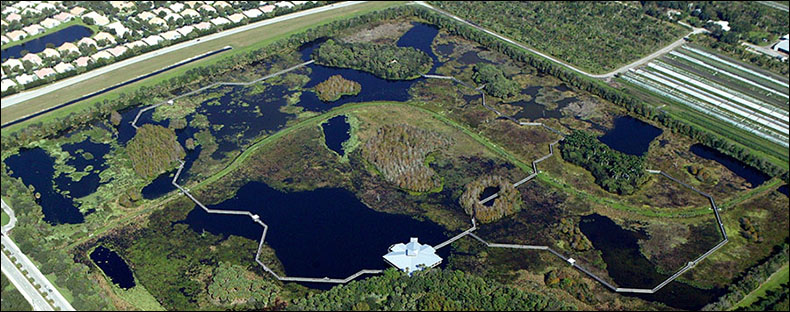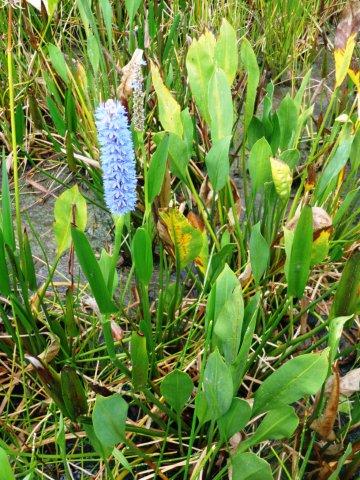QR Zones of Green Cay Wetlands Boardwalk
Back to Introduction

 Follow this link to see a video presentation of this zone!
Follow this link to see a video presentation of this zone!
Zone 4 consists of two differing habitats; a cabbage palm hammock, and an open, wet, prairie-like area. Similar to the hardwood hammock, the cabbage palm hammock is located in an area of higher elevation, but is dominated by cabbage palm. The cabbage palm hammock played an important role in the life of the Seminole Indians. The cabbage palms provided palm branches, which were used for thatching chickee huts and making baskets. The heart of the cabbage palm is edible and tastes similar to commercially sold hearts of palm. Cabbage palm berries also provide food for animals such as deer, bears, raccoons and wild turkeys. The cabbage palm is Florida’s official state tree. The open, or wet prairie area in this zone contains the tall, emergent broadleaf plants and grasses found in the other wetland zones, as wells as a few snags, or standing dead trees. The ponded water in this zone is an excellent location to see ducks most of the year.
Trees and Understory: Live Oak, Cabbage/Sabal Palm, Strangler Fig, American Beautyberry, Royal Fern, Corky Passionvine, Wild Coffee, Myrsine, Wild Petunia.
Wetland Plants: Arrowhead/Duck Potato, Knotted Spikerush, Giant Bulrush, Gulf Coast Spikerush, Bulrush Pickerelweed, Water Lettuce.
Animals: Limpkin, Mottled Duck, Blue Winged Teal, Green Winged Teal, Cormorant, Grebe, Snakes, Tree Frogs, Alligators.

BLUE AND GREEN WINGED TEAL - Pairs and small groups of these tiny dabbling ducks inhabit shallow ponds and wetlands across much of North America. Green winged teal prefer marsh areas more than the open water of the Blue winged teal. Teal are long distance migrants, with some birds heading all the way to South America for the winter. Therefore, they take off early on spring and fall migration, leaving their breeding grounds in the United States and Canada well before other species in the fall. Blue winged teal eat a more varied diet of aquatic insects such as midge larvae, crustaceans, clams, and snails as well as vegetation and grains, while the blue winged prefers a more vegetative diet. The Blue-winged Teal are the second most pabundant duck in North America, behind the Mallard.

STRANGLER FIG - This plant starts out as an epiphyte and attaches to a host tree, usually a cabbage palm. The strangler fig sends out roots that tangle around the host and eventually strangles it. Still the strangler fig fills an important niche and food source to many tropical forest hammock creatures. Many forms of life are attracted to the fig tree because of its production of large amounts of fig fruits and can be the only source of food during certain seasons.

LIMPKIN (also called crying bird) - A bird that looks like a large rail but is skeletally closer to cranes. It is found mostly in wetlands in warm parts of the Americas, from Florida to northern Argentina. It feeds on mollusks, with the diet dominated by apple snails of the genus Pomacea. Its name derives from its seeming limp when it walks. Limpkins are largely nocturnal and crepuscular, except that in Florida refuges, where they do not fear people, they are active during the day.]Even so, they are usually found near cover. ]Because of their long toes, they can stand on floating water plants. They also swim well, both as adults or as newly hatched chicks, but they seldom do so. They fly strongly, the neck projecting forward and the legs backward, the wings beating shallowly and stiffly, with a jerky upstroke, above the horizontal most of the time.

ARROWHEAD - An emersed plant. It's large leaves and conspicuous flowers make it easy to find in the wild. It grows commonly in swamps, ditches, lakes, and stream margins. Arrowhead is also called duck potato because of its potato-like, underground corms that sometimes form. Duck potato has large, firm, lance-shaped leaves, which are typically four inches wide and up to two feet long. Also called Duck Potato.

WATER LETTUCE - Water Lettuce has velvety foliage that spreads like strawberry plants across the surface, occasionally producing inconspicuous white flowers. The bright green leaves are deeply veined and resemble heads of floating lettuce, hence the name. Water Lettuce is an important floating plant for wetlands as they provide shade for underwater residents, as well as a safe haven and spawning area for fish. They also help oxygenate and clarify the water and will use the extra organic nutrients, reducing algae production. Especially important in a nutrient-rich wetland like Green Cay!

PURPLE MARTINS' HOUSES - Purple Martins in eastern North America nest exclusively in artificial gourds/houses but in the West they still use mostly natural cavities. Their range is throughout most of the Eastern U.S. and Canada with some migration up the west coast of the U.S. They make the trip either via Central America or down the Florida peninsula, through the Florida Keys and Bahamas and across the Gulf of Mexico to South America. Martins are good fliers, and under normal circumstances the trip is not too hazardous, but a large storm in the Gulf of Mexico at the wrong time can devastate a migrating flock.

PIED-BILLED - The Pied-billed Grebe is common across many of North America’s small, quiet ponds and marshes where thick vegetation grows out of the water. These small birds have unusually thick bills that turn silver and black in summer. Pied-Billed Grebes are expert divers with the ability to adjust their buoyancy in a way that allows them to float with just the upper half of the head above the water. They use their chunky bills to eat large crustaceans along with a great variety of fish, amphibians, insects, and other invertebrates. Rarely seen in flight and often hidden amid vegetation, Pied-billed Grebes announce their presence with loud, far-reaching calls. They build floating nests of cattails, grasses, and other vegetation.

MOTTLED DUCK - The mottled duck a non-migratory, close relative of the mallard. The Florida mottled duck, often called the Florida duck or Florida mallard, is a unique subspecies found only in peninsular Florida, residing in both brackish and freshwater marshes. Because the plumages of male and female mottled ducks are similar, the easiest way to tell them apart is by bill color. The male mottled duck has an olive green to yellow, solid color bill, while the female has an orange to brown bill with dark blotches or dots. Approximately 40 percent of the mottled duck's diet consists of animal matter such as insects, snails, mollusks, crayfish and small fish. The remainder of its diet is composed of grass seeds, stems, and roots; seeds of other marsh plants; and bayberries. The long-term well-being of Florida mottled ducks is threatened by crossbreeding with feral, domesticated mallards and the FWC is working hard to combat this problem.

DOUBLE-CRESTED CORMORANTS - The most widespread cormorant in North America, and the one most frequently seen in freshwater. They breed on the coast as well as on large inland lakes. They form colonies of stick nests built high in trees on islands or in patches of flooded timber. Double-crested Cormorants float low on the surface of water and dive to catch small fish. After fishing, they stand on docks, rocks, and tree limbs with wings spread open to dry. In flight, they often travel in V-shaped flocks that shift and reform as the birds alternate bursts of choppy flapping with short glides. Cormorants often stand in the sun with their wings spread out to dry. They have less preen oil than other birds, so their feathers can get soaked rather than shedding water like a duck’s. Though this seems like a problem for a bird that spends its life in water, wet feathers probably make it easier for cormorants to hunt underwater with agility and speed.

PICKEREL WEED - A very common and widely recognized native. It occurs throughout Florida and flowers year-round. Pickerelweed is an aquatic plant which grows three to four feet tall. Usually, you only see one or two feet, because the rest is underwater. Pickerelweed leaves are large and heart-shaped, growing up to 10 inches long. They have a long petiole (leaf stem). Pickerelweed grows in shallow freshwater, such as marshes, pond edges, lakes, and streamsides. This plant is most often recognized by its beautiful flowers. Pickerelweed has large spikes with clusters of violet-blue flowers. Each flower is small, less than half an inch wide. It has two small yellow spots on one petal. The nectar of Pickerelweed flowers attracts many insects, including bees and butterflies. Pickerelweed has long light green stems which stretch down under the water to an underground stem called a rhizome. Rhizomes grow in the muddy bottom and spread with roots to send up more Pickerelweed stems to the surface.

CABBAGE PALM - Also known as Sabal Palm. Florida designated the sabal palm (Sabal palmetto) as the official state tree in 1953. The sabal palm (also known as cabbage palm, palmetto, or cabbage palmetto) is the most widely distributed palm tree in Florida. It grows in almost any soil and has many uses, including food, medicine, and landscaping. Sabal palm trees grow up to 20 m in height. Sabal is a fan palm native to the southeastern United States, Cuba, and the Bahamas. The growing heart of the new fronds (also known as the terminal bud), gives the palm tree its "cabbage" name, since this can be harvested as a food and resembles a cabbage head in shape (this is the key ingredient for a "heart of palm salad")" This was a common food for native Americans, but this practice is very destructive because it will kill the palm (the terminal bud is the only point from which the palm can grow and without this bud the palm will not be able to replace old leaves and will eventually die).

CYPRESS SWAMP - A swamp is defined as a wetland dominated by trees. Here in South Florida, because the Cypress tree can withstand immersion in water better than the other trees that reside in the Flood Plain Areas, it’s the cornerstone tree for the transition to the aptly named Cypress Swamp. This zone is flooded for most, if not all of the year. Only in the driest of the dry season would a cypress swamp not have standing water and even then the soil is usually damp or mucky. Because of this, typically the only animals found here are aquatic species such as snakes, otters and lizards. More land-based animals like deer, bobcats, panthers and hogs may transition through the area during the drier times of year. Other plants growing in the area are spikerush, cocoplum, willow and wax myrtle.
Green Cay Nature Center and Wetlands is owned and operated by the
Palm Beach County Parks and Recreation Department and the
Water Utilities Department.